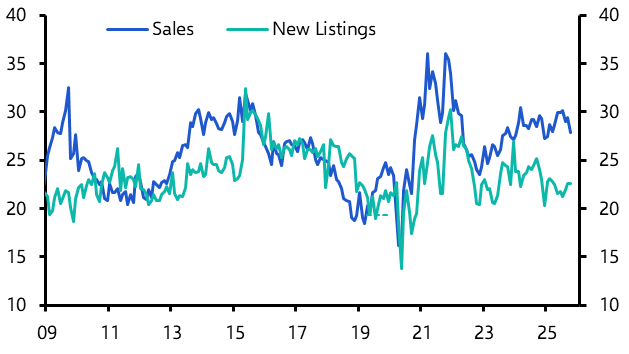This is being called a global monetary tightening cycle – but it’s not strictly “global”. While 41 of the 50 central banks under our coverage have raised rates so far, and we expect others to join them – most notably the European Central Bank – the People’s Bank of China (PBOC) and Bank of Japan (BoJ) are bucking the global trend and keeping policy loose.
In China, the Loan Prime Rate published by the PBOC has been cut by 15 basis points since last December and restrictions on lending by commercial banks have been eased. Meanwhile, the BoJ is on track to purchase around Y15trn of government debt this month – leaving it as the only major central bank still engaged in buying significant quantities of assets. With global rates set for the most aggressive surge since the Volcker Shock of the early 1980s, can these banks continue to go against the grain?
Viewed in purely domestic terms, the policies of both the BoJ and the PBOC make sense. After all, neither bank is facing the same inflationary challenge as their counterparts in Europe or North America.
Headline CPI is running at just over 2% in both countries, while core inflation is currently 0.9% in China and 0.8% in Japan. That compares to latest core inflation rates of 6% in the US and 3.8% in the euro-zone. (See Chart 1.) Defeating deflation on a lasting basis remains the dominant policy challenge in Japan. Meanwhile, China’s economy is facing multiple headwinds, to the extent that we now think it won’t grow at all this year. All of this points to the need for looser rather than tighter monetary policy in both countries. The key issue is whether either central bank now gets dragged along by the global trend towards higher interest rates.
Chart 1: Core CPI Inflation in Major Economies (Latest, % y/y)
 Sources: Refinitiv, Capital Economics
Sources: Refinitiv, Capital Economics
Much depends on the openness of each country’s capital account, and therefore the extent to which flows in and out of each economy are buffeted by changes in interest rates elsewhere in the world.
China imposes a broad range of capital controls that significantly insulate the PBOC from what other central banks are doing. This allows policymakers greater room to diverge from global norms. Although some sensitivity to the global surge in interest rates means we don’t expect any further to cuts to its policy rate, we do think the PBOC will further loosen quantitative controls on credit. This in turn should put more downward pressure on yields on local currency sovereign bonds, even as yields on government debt in the US and other major economies continue to rise.
Japan is open to global capital flows and so, as bond yields in other countries have moved up, the BoJ has found that its commitment to a policy of Yield Curve Control – keeping 10-year JGB yields within a 25bps band either side of zero – has been tested by global investors.
The recent sell-off in global bond markets has pushed the 10-year JGB yield right to the upper limit of the BoJ’s range (see Chart 2), forcing it to purchase increasing amounts of government debt to maintain its target – by some measures, if it carried on buying at this month’s pace, it would own the entire market of outstanding JGBs within a year.
Chart 2: 10-year JGB Yields (%)
 Sources: Refinitiv, Capital Economics
Sources: Refinitiv, Capital Economics
The BoJ has mounted a staunch defence of its yield target even as other central banks wind up their purchase programmes and begin to tighten policy. This has created substantial downward pressure on the yen, which has fallen by around 15% against the US dollar this year.
China and Japan’s different experiences are a neat illustration of what economists call the “impossible trinity”. This theory says that a central bank can pursue at most two of the following three policies: an open capital account, control over its exchange rate, and independent monetary policy.
China imposes capital controls, meaning it retains control over both its currency and monetary policy. In contrast, Japan’s relatively open capital account means it relinquishes control over the yen to maintain sovereignty over monetary policy.
Of course, monetary policymaking is less black and white than the textbooks suggest – it operates in shades of grey. The renminbi has come under some pressure in recent months, which the PBOC has tolerated, not least because it is perceived to help the struggling economy. And we still expect the BOJ to give some ground in its defence of Yield Curve Control by widening its target range.
That wouldn’t be without risk: once the BoJ blinks and adjusts its Yield Curve Control policy, it will only be a matter of time before investors again test its resolve to hold the line at the new target. And the fundamental point remains that in a world of rising rates, any attempt by the BoJ to buck that trend will result in a weaker yen.
Of course, a markedly weaker currency might be a positive development for an economy struggling to emerge from three decades of deflation. But large and rapid currency moves can be destabilising. At some point something gives – either because balance sheets start to come under strain or because imported inflation becomes a problem.
A lot will depend on just how far interest rates in other major economies have to rise. But if we are in the foothills of a large and sustained increase in global interest rates, the PBOC will find it easier to chart its own course than the BoJ.
What you may have missed:
- Our Markets team briefed clients on their new forecasts and followed up with a note addressing the key questions.
- Olivia Cross from our Commodities team explained our outlook for agricultural staples.
- Senior Property Economist Matthew Pointon showed clients how to track a housing downturn.




